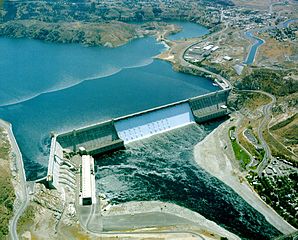The conversation today picks up on what I had written in: “In a warm, dry and mobile California, water rationing, mileage fees possible.”
In that post I had rationalized that “[l]ess water usage could mean more energy savings, and this could, to some extent, counter the effects of the increase in driving which, no doubt, has added more pollution to the air.” Am I correct?
So, stated in the “New Report Reveals Drought Increases Energy Costs and Climate-Changing Pollution” press release of Mar. 17, 2015, is this:
“The Pacific Institute, an internationally-renowned independent think tank focused on water issues, released a report that reveals diminished river flows have resulted in less hydroelectricity, more expensive electricity, and increased production of greenhouse gas emissions.”
The Pacific Institute goes on in the release by explaining, “Under normal conditions, electricity for the state’s millions of users is produced from a blend of many sources, with natural gas and hydropower being the top two. Since the drought has reduced the state’s river flows that power hundreds of hydropower stations, natural gas has become a more prominent player in the mix. This is an expensive change.”

The Oakland-based think tank went on to declare that between 2011 and 2014, in supplying electricity for Californians, a larger share has come via the natural-gas-burning process with less reliance on a hydropower-based supply, and from this, California power-plant-released carbon dioxide and other pollutant emissions have risen by eight percent.
If the present dry spell continues unabated, a diminishing water supply will mean less in the way of hydroelectric generation, and that points toward increased reliance on electricity produced from other sources – renewable and non-renewable alike.
Though all may be accurate, this is only part of the California energy production/energy consumption story.
Case in point: From “Ground lost in 2012 vs 2011 in California GHG-emissions-reduction fight,” following are a few of the particulars from that post.
“The California Environmental Protection Agency Air Resources Board (ARB) … released its latest greenhouse gas emissions inventory report for California: ‘California’s Greenhouse Gas Emission Inventory: 2000-2012’ in May 2014. In the effort to lower in the atmosphere overall levels of greenhouse gas emissions, on this front, what, if any, progress has been made and, in its effort to appreciably reduce its GHG, is California winning the war?
“Here is what I learned: ‘In 2012, total GHG and per capita emissions increased by 1.7% from 2011 emissions. This increase was driven largely by the increased reliance on natural gas-generation sources of in-state electricity due to the closure of the San Onofre Nuclear Generating Station (SONGS) as well as dry hydrological conditions in 2012 (drought) causing a drop in the in-state hydropower generation. Total statewide greenhouse gas emissions have decreased from 466 million [metric] tonnes of carbon dioxide equivalent (MMTCO2e) in 2000 to 459 MMTCO2e in 2012, a decrease of 1.6 percent,’ as reported by the ARB.”
So, as a result of the SONGS being decommissioned and going off-line combined with California’s ongoing drought, the relationship between in-state power generated renewably relative to that which is produced non-renewably, has obviously changed.
Coupled with all of the above, what would be helpful is knowing exactly what California’s electric bill is, or, in other words, how many megawatts are being consumed by the various in-state consumers. From year to year, is the bill higher, lower or holding steady? During the drought, with much agricultural land being fallowed (pulled out of production to cut back on water usage) which, in turn, means reduced need for electricity to feed electric pumps and to drive irrigation systems, what is the impact on the state’s electric grid from this? Ditto regarding automatic sprinkler systems used in watering home, business, municipal, highway right-of-way and other landscapes? The presumption is conservation measures are enabling the saving of water and water saved could translate into volts saved as it has to do with the cut-backs made.
Adds the Pacific Institute in the release: “According to the Institute’s report, between October 2011 and October 2014, California’s ratepayers spent $1.4 billion more for electricity than in average years because of the drought-induced shift from hydropower to natural gas. In an average year, hydropower provides 18 percent of the electricity needed for agriculture, industry, and our homes. Comparatively, in this three-year drought period, hydropower comprised less than 12 percent of total California electricity generation.”
Whether a move farther away from less-sustainable (coal, natural gas, oil) sources and toward more renewables (sun, wind, tide, geothermal) for the supply of electricity, remains to be seen.
As it currently stands, 23 percent of Golden State-produced electricity comes from renewable sources. State mandate, however, stipulates that a third of California’s energy will need to be renewably produced by 2020. The idea is to up that even more.
Image above: U.S. Department of the Interior, Bureau of Reclamation
– Alan Kandel
This post was last revised on Mar. 15, 2020 @ 8:45 a.m. Pacific Daylight Time.